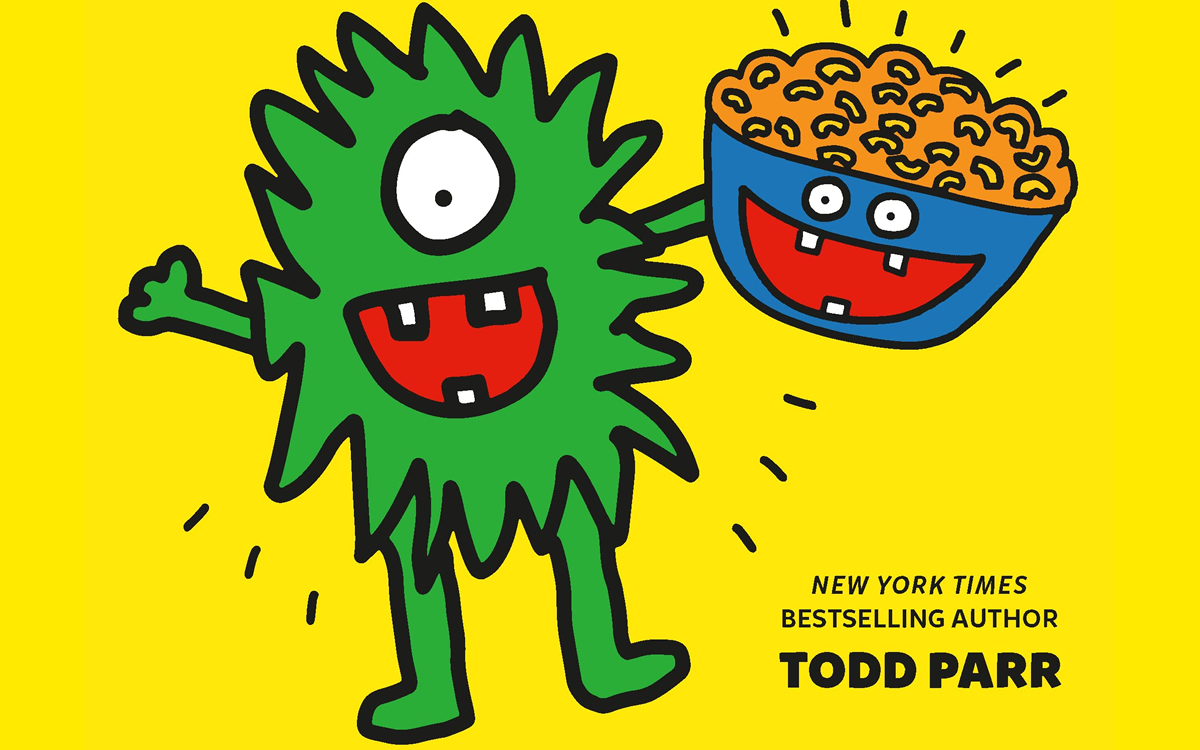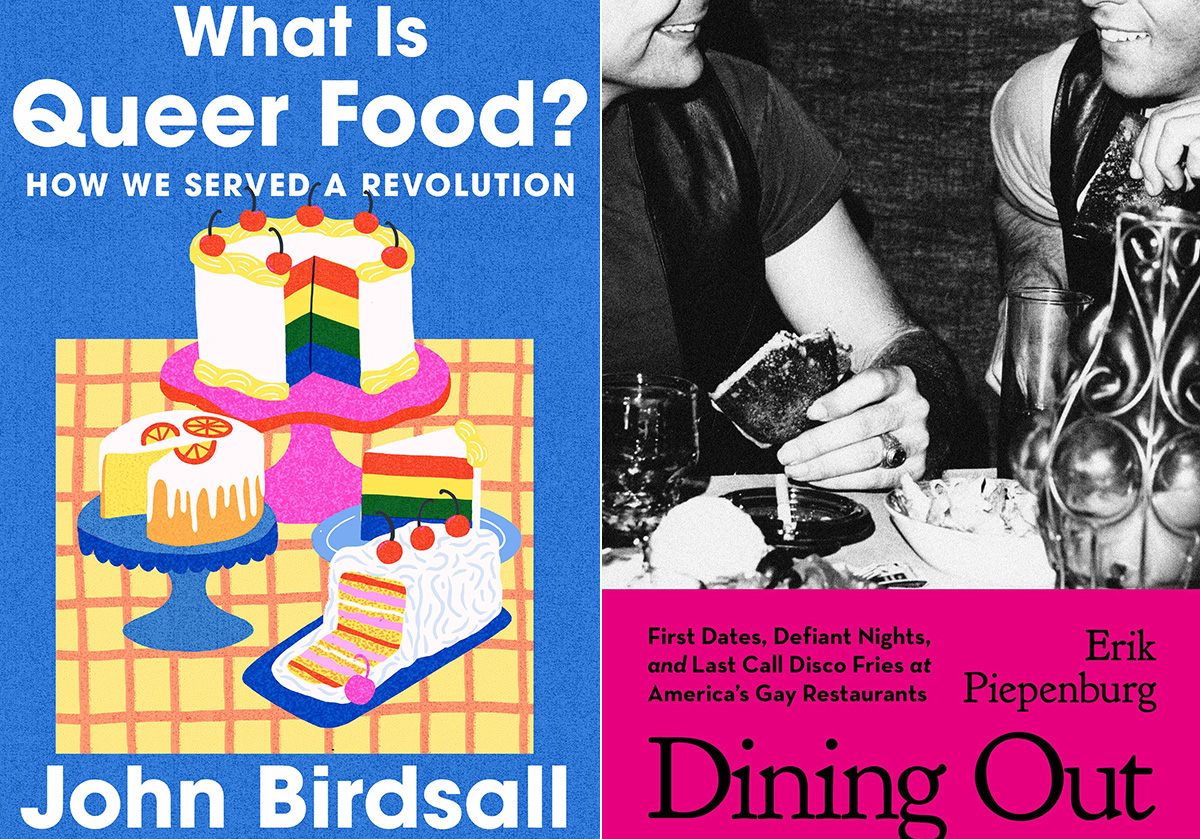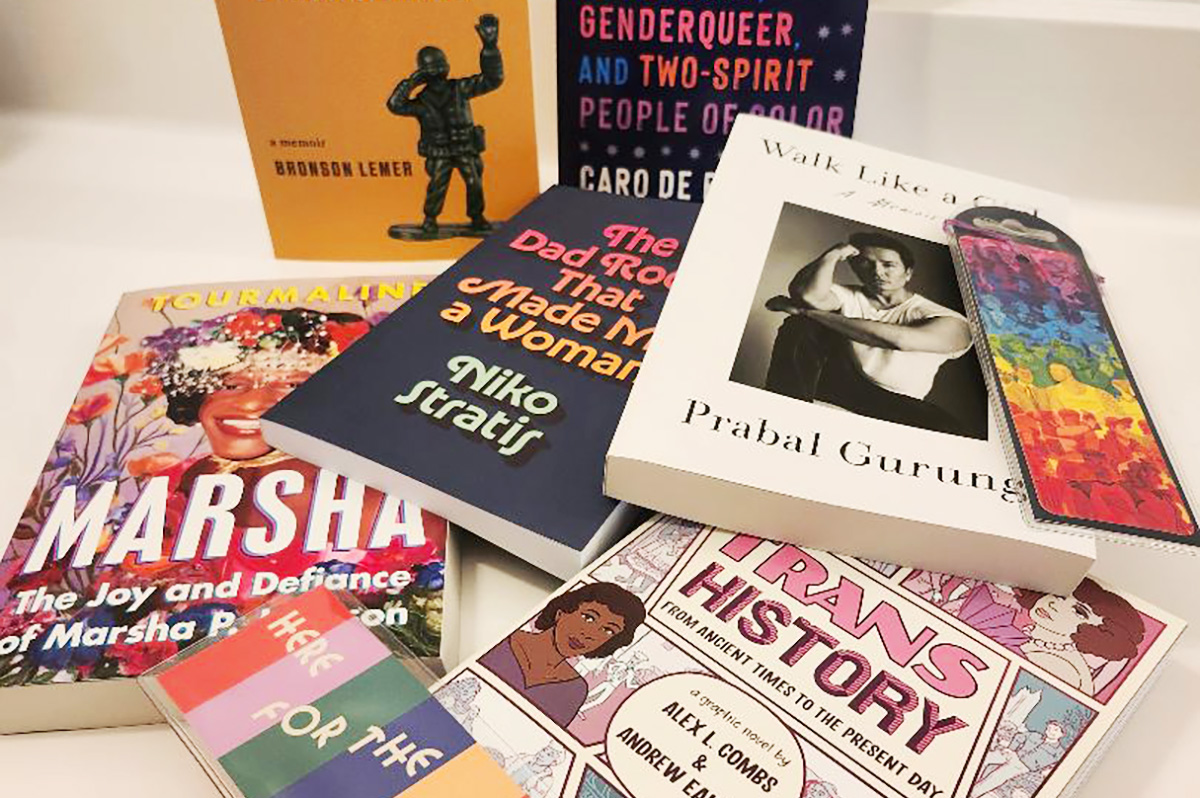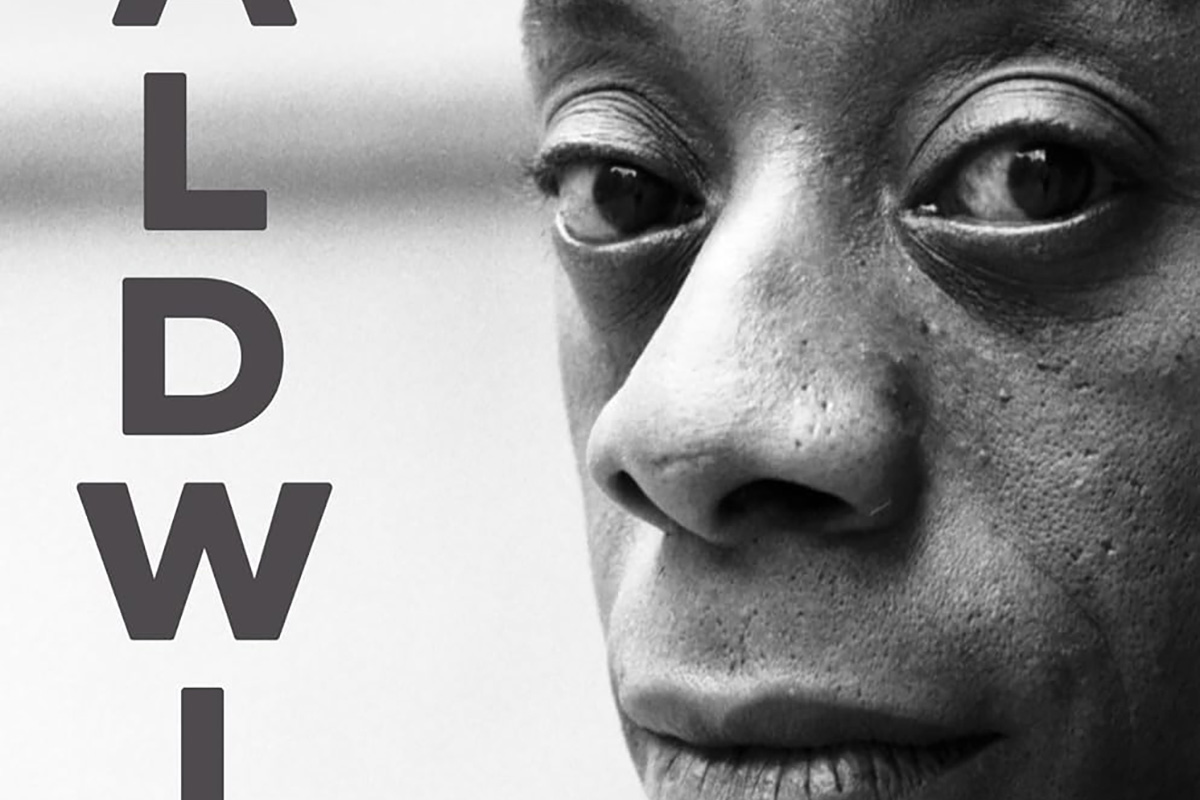Books
Oft banned gay author’s new kids’ book a fun treat
‘Monster Mac and Cheese Party’ brimming with humor, color

It’s the hottest party ever! A green, one-eyed, three-toothed fuzzy monster has invited a sea monster, a bat, a witch, and other guests to bring and eat mac and cheese. The witch favors “glow-in-the-dark mac with snakes and furballs.” The bat enjoys “mac ‘n’ bugs.”
Whether you’re eight or 80, wouldn’t you like to crash this gathering?
Thanks to bestselling, award-winning, gay children’s book author and artist Todd Parr, we can all join in the fun.
“The Monster Mac and Cheese Party” (Little, Brown Books for Young Readers), Todd’s newest book, replete with his signature, eye-catching art, is a celebration of hanging out and scarfing down your fave food with your friends (monsters and human). The picture book written for 4-8 year-olds, is a fun-read for mac-and-cheese-and-monster-aficionados of any age. Except, perhaps, for those who’ve called for Parr’s books to be banned.

Parr, author of “It’s Okay to Be Different,” “The Family Book” and other much-loved as well as often-banned children’s books, is known for fostering values of kindness and inclusivity in his work. Not through preaching or boring messaging. But through bold images — art brimming with humor and bright colors. There are few words. But the words Parr uses are just what kids would say.
Take “The Family Book” which features Parr’s bright-hued illustrations. “Some families are big, some families are small,” Parr, who was born in 1962, writes in “The Family Book,” published in 2003, “… some families have two moms and two dads.”
You might think this message of inclusivity wouldn’t have caused a ruckus. But you’d be wrong. “The Family Book” was one of the most banned picture books of the 2021-2022 school year, according to Pen America.
“Every time a book is banned, we’re denied our right to learn freely,” the American Civil Liberties Union said in a statement accompanying a video of actor Randall Park reading “The Family Book” on Father’s Day on You Tube.
“My goal in the book was to make every kid feel that no matter what kind of family they have, that their family is special,” Parr, who lives in Southern California with his adopted pit bulls, said in an interview with the Blade.
Parr knew some people might not like “The Family Book” and that it might be banned. “It didn’t matter to me,” he said, “One page [that mentions two moms or two dads being parents] generates a lot of hate.”
“Like drag queens reading stories to kids,” Parr added, “it’s a free-for-all on social media.”
Parr wrote the mac-and-cheese book because after the pandemic, kids “needed a break,” he said.
After COVID, “we didn’t want to think about the feelings we’ve experienced,” Parr said, “we just wanted to feel good again.”
His publisher had asked him to do a Halloween book, and mac and cheese is one of Parr’s favorite things. The book contains kid-friendly recipes for “Todd Mac” and “Vegan Mac”.
“Thick black lines and neon colors make for a zany tale,” “Kirkus” said of “The Monster Mac and Cheese Party, ” “perfect for group read-alouds. Parr keeps the laughs coming fast and furious.”
Parr has written and illustrated more than 60 children’s books. His work has been translated into 20 languages. More than 6.3 million copies of his books have been sold.
Parr is the co-creator with Gerry Renert of SupperTime Entertainment of the Daytime Emmy-nominated animated TV series “ToddWorld.” Several short films for “Sesame Street” were based on Parr’s work.
Parr gets what it’s like to feel different, hurt or sad, Juanita Giles wrote in “When In Doubt Pretend To Be Todd Parr,” an essay for NPR. “Todd Parr knows my son’s long hair makes him different,” Giles wrote, “Todd Parr knows our best friends moved away and our dog died.”
Growing up gay in a small town in Wyoming, Parr had no inkling that he’d be so successful, acclaimed and loved.
“I never had a moment where I told everybody ‘I’m gay,’” Parr said, “It was a matter of fact and no one really questioned it.”
But things weren’t easy. Parr wasn’t sure himself. “I had girlfriends,” he said, “I felt guilty that I had feelings [of liking boys] but I did.”
In school, people called Parr a “faggot” before he knew what it meant. “I felt very different like I was on another planet,” he said.
Growing up, being gay wasn’t Parr’s only challenge. “I had to repeat second grade,” he said, “because I couldn’t read.”
“They thought I was lazy,” Parr added.
Years later, Parr learned that he had dyslexia and attention deficit hyperactivity disorder (ADHD). People didn’t know what these disabilities were when he was in school.
“My grandpa on my Dad’s side was talented,” Parr said, “and my grandma on my Mom’s side was talented and creative.”
In the second grade, Parr focused on drawing. He won an art contest but his parents didn’t believe that he’d drawn the picture. “They thought I traced it,” Parr said.
Parr felt that he had to get out of his home town. “There was energy calling me,” he said, “there was a bigger world out there. I knew, one day, I would leave Wyoming.”
Parr became a flight attendant for United for 15 years. “That job – traveling around the world – gave me confidence,” Parr said.
Parr traveled to new cities. He went back to art with a new sense of confidence. With role models like Keith Haring, the renowned American gay artist. “Haring showed you that art can be whimsical,” Parr said, “that you could use bright colors.”
Parr lived in San Francisco. He began to have some success with his art. His work was displayed in one of Wolf Gang Puck’s restaurants.
But Parr was still borrowing money and flying for United. “I was spinning my wheels,” he said.
He decided to perform a magic show (that he did for kids) in Las Vegas. There, he met his agent – a married couple who understood his work. They got him a literary agent. “It freed me up to do creative things,” Parr said.
One day, Parr was showing his work at a show in New York. “I don’t like to read,” Parr said when he was asked if he’d thought about writing children’s books.
Parr signed with Little Brown for Young Readers when he realized he was on to something. He could write books for kids with his arts with messages (but without characters).
For a time, Parr felt apologetic about his dyslexia. “I’m not qualified to be up there [because of his struggles in school],” he said when he was asked to give a keynote speech.
But after talking with his editor about his fears, Parr wondered: why shouldn’t he own his dyslexia? Why not be honest and talk about it?
“It opened a path for me,” Parr said.
Parr’s website is toddparr.com.
The Blade may receive commissions from qualifying purchases made via this post.
Books
Two new books on dining out LGBTQ-style
Visit nightclubs, hamburger joints, and a bathhouse that feeds customers

‘What is Queer Food? How We Served a Revolution’
By John Birdsall
c.2025, W.W. Norton
$29.99/304 pages
‘Dining Out: First Dates, Defiant Nights, and Last Call Disco Fries at America’s Gay Restaurants’
By Erik Piepenburg
c.2025, Grand Central
$30/352 pages
You thought a long time about who sits where.
Compatibility is key for a good dinner party, so place cards were the first consideration; you have at least one left-hander on your guest list, and you figured his comfort into your seating chart. You want the conversation to flow, which is music to your ears. And you did a good job but, as you’ll see with these two great books on dining LGBTQ-style, it’s sometimes not who sits where, but whose recipes were used.
When you first pick up “What is Queer Food?” by John Birdsall, you might miss the subtitle: “How We Served a Revolution.” It’s that second part that’s important.

Starting with a basic gay and lesbian history of America, Birdsall shows how influential and (in)famous 20th century queer folk set aside the cruelty and discrimination they received, in order to live their lives. They couldn’t speak about those things, he says, but they “sat down together” and they ate.
That suggested “a queer common purpose,” says Birdsall. “This is how who we are, dahling, This is how we feed our own. This is how we stay alive.”
Readers who love to cook, bake or entertain, collect cookbooks, or use a fork will want this book. Its stories are nicely served, they’re addicting, and they may send you in search of cookbooks you didn’t know existed.
Sometimes, though, you don’t want to be stuck in the kitchen, you want someone else to bring the grub. “Dining Out” by Erik Piepenburg is an often-nostalgic, lively look at LGBTQ-friendly places to grab a meal – both now and in the past.

In his introduction, Piepenburg admits that he’s a journalist, “not a historian or an academic,” which colors this book, but not negatively. Indeed, his journeys to “gay restaurants” – even his generous and wide-ranging definitions of the term – happily influence how he presents his narrative about eateries and other establishments that have fed protesters, nourished budding romances, and offered audacious inclusion.
Here, there are modern tales of drag lunches and lesbian-friendly automats that offered “cheap food” nearly a century ago. You’ll visit nightclubs, hamburger joints, and a bathhouse that feeds customers on holidays. Stepping back, you’ll read about AIDS activism at gay-friendly establishments, and mostly gay neighborhood watering holes. Go underground at a basement bar; keep tripping and meet proprietors, managers, customers and performers. Then take a peek into the future, as Piepenburg sees it.
The locales profiled in “Dining Out” may surprise you because of where they can be found; some of the hot-spots practically beg for a road trip.
After reading this book, you’ll feel welcome at any of them.
If these books don’t shed enough light on queer food, then head to your favorite bookstore or library and ask for help finding more. The booksellers and librarians there will put cookbooks and history books directly in your hands, and they’ll help you find more on the history and culture of the food you eat. Grab them and you’ll agree, they’re pretty tasty reads.
The Blade may receive commissions from qualifying purchases made via this post.

You’re going to be on your feet a lot this month.
Marching in parades, dancing in the streets, standing up for people in your community. But you’re also likely to have some time to rest and reflect – and with these great new books, to read.
First, dip into a biography with “Marsha: The Joy and Defiance of Marsha P. Johnson” by Tourmaline (Tiny Rep Books, $30), a nice look at an icon who, rumor has it, threw the brick that started a revolution. It’s a lively tale about Marsha P. Johnson, her life, her activism before Stonewall and afterward. Reading this interesting and highly researched history is a great way to spend some time during Pride month.
For the reader who can’t live without music, try “The Dad Rock That Made Me a Woman” by Niko Stratis (University of Texas Press, $27.95), the story of being trans, searching for your place in the world, and finding it in a certain comfortable genre of music. Also look for “The Lonely Veteran’s Guide to Companionship” by Bronson Lemer (University of Wisconsin Press, $19.95), a collection of essays that make up a memoir of this and that, of being queer, basic training, teaching overseas, influential books, and life.
If you still have room for one more memoir, try “Walk Like a Girl” by Prabal Gurung (Viking, $32.00). It’s the story of one queer boy’s childhood in India and Nepal, and the intolerance he experienced as a child, which caused him to dream of New York and the life he imagined there. As you can imagine, dreams and reality collided but nonetheless, Gurung stayed, persevered, and eventually became an award-winning fashion designer, highly sought by fashion icons and lovers of haute couture. This is an inspiring tale that you shouldn’t miss.
No Pride celebration is complete without a history book or two.
In “Trans History: From Ancient Times to the Present Day” by Alex L. Combs & Andrew Eakett ($24.99, Candlewick Press), you’ll see that being trans is something that’s as old as humanity. One nice part about this book: it’s in graphic novel form, so it’s lighter to read but still informative. Lastly, try “So Many Stars: An Oral History of Trans, Nonbinary, Genderqueer, and Two-Spirit People of Color” by Caro De Robertis (Algonquin Books of Chapel Hill. $32.00) a collection of thoughts, observations, and truths from over a dozen people who share their stories. As an “oral history,” you’ll be glad to know that each page is full of mini-segments you can dip into anywhere, read from cover to cover, double-back and read again. It’s that kind of book.
And if these six books aren’t enough, if they don’t quite fit what you crave now, be sure to ask your favorite bookseller or librarian for help. There are literally tens of thousands of books that are perfect for Pride month and beyond. They’ll be able to determine what you’re looking for, and they’ll put it directly in your hands. So stand up. March. And then sit and read.
a&e features
James Baldwin bio shows how much of his life is revealed in his work
‘A Love Story’ is first major book on acclaimed author’s life in 30 years

‘Baldwin: A Love Story’
By Nicholas Boggs
c.2025, FSG
$35/704 pages
“Baldwin: A Love Story” is a sympathetic biography, the first major one in 30 years, of acclaimed Black gay writer James Baldwin. Drawing on Baldwin’s fiction, essays, and letters, Nicolas Boggs, a white writer who rediscovered and co-edited a new edition of a long-lost Baldwin book, explores Baldwin’s life and work through focusing on his lovers, mentors, and inspirations.
The book begins with a quick look at Baldwin’s childhood in Harlem, and his difficult relationship with his religious, angry stepfather. Baldwin’s experience with Orilla Miller, a white teacher who encouraged the boy’s writing and took him to plays and movies, even against his father’s wishes, helped shape his life and tempered his feelings toward white people. When Baldwin later joined a church and became a child preacher, though, he felt conflicted between academic success and religious demands, even denouncing Miller at one point. In a fascinating late essay, Baldwin also described his teenage sexual relationship with a mobster, who showed him off in public.
Baldwin’s romantic life was complicated, as he preferred men who were not outwardly gay. Indeed, many would marry women and have children while also involved with Baldwin. Still, they would often remain friends and enabled Baldwin’s work. Lucien Happersberger, who met Baldwin while both were living in Paris, sent him to a Swiss village, where he wrote his first novel, “Go Tell It on the Mountain,” as well as an essay, “Stranger in the Village,” about the oddness of being the first Black person many villagers had ever seen. Baldwin met Turkish actor Engin Cezzar in New York at the Actors’ Studio; Baldwin later spent time in Istanbul with Cezzar and his wife, finishing “Another Country” and directing a controversial play about Turkish prisoners that depicted sexuality and gender.
Baldwin collaborated with French artist Yoran Cazac on a children’s book, which later vanished. Boggs writes of his excitement about coming across this book while a student at Yale and how he later interviewed Cazac and his wife while also republishing the book. Baldwin also had many tumultuous sexual relationships with young men whom he tried to mentor and shape, most of which led to drama and despair.
The book carefully examines Baldwin’s development as a writer. “Go Tell It on the Mountain” draws heavily on his early life, giving subtle signs of the main character John’s sexuality, while “Giovanni’s Room” bravely and openly shows a homosexual relationship, highly controversial at the time. “If Beale Street Could Talk” features a woman as its main character and narrator, the first time Baldwin wrote fully through a woman’s perspective. His essays feel deeply personal, even if they do not reveal everything; Lucian is the unnamed visiting friend in one who the police briefly detained along with Baldwin. He found New York too distracting to write, spending his time there with friends and family or on business. He was close friends with modernist painter Beauford Delaney, also gay, who helped Baldwin see that a Black man could thrive as an artist. Delaney would later move to France, staying near Baldwin’s home.
An epilogue has Boggs writing about encountering Baldwin’s work as one of the few white students in a majority-Black school. It helpfully reminds us that Baldwin connects to all who feel different, no matter their race, sexuality, gender, or class. A well-written, easy-flowing biography, with many excerpts from Baldwin’s writing, it shows how much of his life is revealed in his work. Let’s hope it encourages reading the work, either again or for the first time.
-

 U.S. Supreme Court3 days ago
U.S. Supreme Court3 days agoSupreme Court upholds ACA rule that makes PrEP, other preventative care free
-

 U.S. Supreme Court3 days ago
U.S. Supreme Court3 days agoSupreme Court rules parents must have option to opt children out of LGBTQ-specific lessons
-

 India5 days ago
India5 days agoIndian court rules a transgender woman is a woman
-

 National4 days ago
National4 days agoEvan Wolfson on the 10-year legacy of marriage equality






